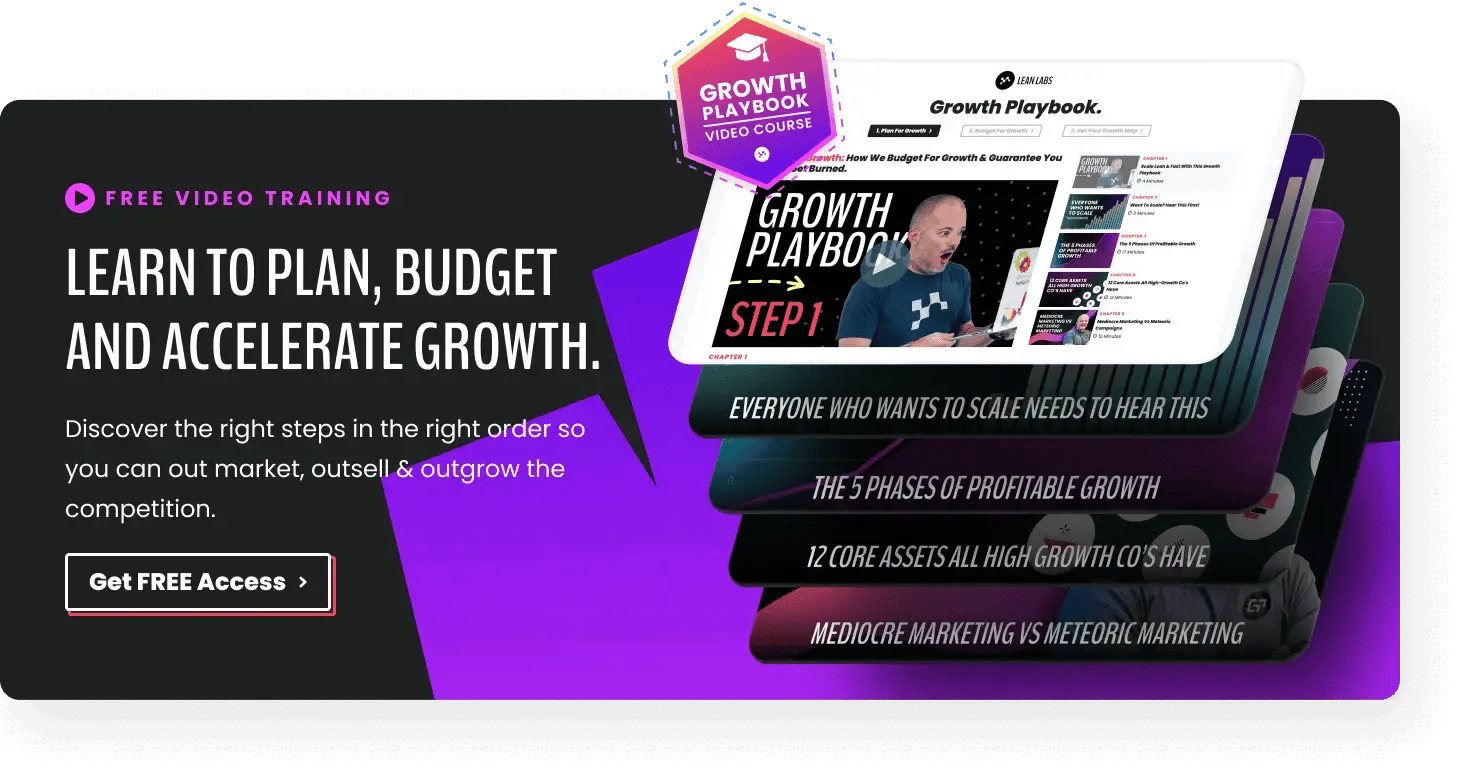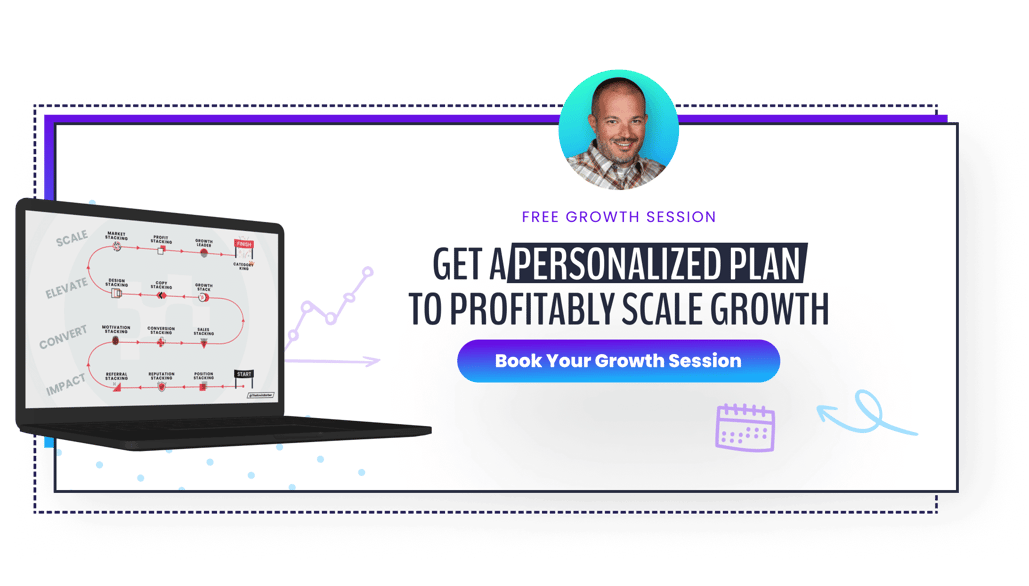No matter how large a body of water is, it will eventually dry up if it doesn’t see rainfall. It’s the same way with your business: No matter how secure you feel now if you don’t have new leads coming into your sales funnel, you’ll end up in trouble down the line.
Have you been relying on paid ads to bring in most of your leads and website traffic? If so, you know how frustrating it can be to see yourself crushing targets… only to find that all your progress melts away the second you reduce your ad spend.
The problem with ads is that they get more expensive and less profitable every month, and once the money is spent, it’s gone. On the other hand, organic is a compound growth model, with your investments paying off for quarters and years after they're made.
Let’s take a look at six incredible organic lead generation strategies you can use to keep your pipeline full to bursting.
3 Lessons From Generating $100M In Client Revenue.
It's not just about generating leads. It’s about generating revenue for your business. Here’s what we’ve learned from working with over 25 startups.
Thanks for submitting the form!
We'll review the information you've submitted and respond to you just as soon as possible.
Why You Need Organic Lead Generation Strategies
You need to fill your pipeline, but why should you pursue an organic lead generation strategy to support that effort?
Organic lead generation is the process of focusing your energies on ranking well in search engines rather than simply using paid ads to generate traffic. In this strategy, new customers will find your business by searching for a product or service online. A portion of those visitors will then convert on an offer on your website and become leads.
Related: B2B Lead Generation: Organic Search Vs. Pay-Per-Click
Advantages of Organic Lead Generation
Organic lead generation is profitable: Your target customers search for solutions to their problems online daily. Winning a place in those rankings and attracting the attention of people actively looking for a solution like yours pays off.
Organic lead generation provides long-term gains: Paid ads can bring traffic to your site fast… but as soon as you turn off those ads, the traffic goes with them. When you invest in content designed to rank, you’ll see leads from that content for months or years after it’s done and published.
Organic lead generation builds trust: To win with organic lead gen, you need to create content your target audience finds valuable. Providing valuable, ungated content builds trust and rapport with your customers.
Challenges of Organic Lead Generation
This strategy has challenges as well as benefits. The chief challenge of organic lead gen is that this method requires patience.
Firstly, organic lead generation can be time-consuming. You must conduct research, create valuable content, then optimize that content for search engines. Each of these steps requires time and expertise.
Additionally, though this strategy produces excellent long-term results, getting an overnight win is challenging. Patience wins with this method. View your organic pipeline like a garden: You prepare the bed, plant the seeds, water them and wait. And plant some more seeds and water some more. Soon enough, you’ll have a sprout, and then a plant, and then delicious tomatoes.
Best Organic Lead Generation Strategies
- Know your Audience
- Embrace Content Marketing
- Optimize your Website
- Send Valuable Emails
- Consider a Chatbot
- Leverage Remarketing
1. Know Your Audience
Our first organic lead generation strategy you need to try is knowing your audience. You want more leads, right?
Wrong.
You want more of the right leads. It doesn’t matter how many leads you bring to your website if they’re all poor-fit customers who won’t close anyways. You’ll need to understand who you’re targeting to crush your organic lead gen efforts. The easiest way to accomplish this is by creating buyer personas.
Your buyer personas are fictional representations of your ideal customers. You’ll identify your target customers' motivations, online behavior patterns, and pain points, then craft all your messaging to meet them where they are and address their needs.
Knowing your audience should be the first step you take in any lead gen initiative. You can learn about your customers by talking with your sales and customer success teams, interviewing customers, and reading through forums that fit your audience’s niche.
2. Embrace Content Marketing
Content marketing and organic lead generation go together like peanut butter and jelly. To succeed with organic lead gen, you must create content your target audience will seek out and find valuable.
When we think of content marketing, we often first think of blogs. Blog writing is a fantastic way to engage with content marketing, but it isn’t the only way. You can also create video content, start a podcast, double down on social media, and more.
Content marketing is an excellent play because it shows your audience that you are trustworthy and knowledgeable. You can use content marketing to establish yourself as a thought leader in your industry. Content allows you to provide value to your potential customers upfront, making them feel more comfortable buying from you when the time comes.
Ensure that you optimize all your content for search engines. This step will help you rank well on Google and reach the people searching for content related to your brand.
Related: How To Choose The Right Keywords For Your SEO
Additionally, you must ensure that you always include CTAs in your content—like this! These calls to action guide the visitor to a natural next step and bring them into your pipeline.
3. Optimize Your Website
Our third strategy is to optimize your website. Optimize the site with the user experience and the buyers’ journey in mind. Start with your site navigation. Visitors should be able to find what they’re looking for quickly and easily, so you need to ensure your navigation is simple and easy to understand.
One way to optimize your navigation is to base your main menu options around the stages of the buyers’ journey. Outline the core problem your visitors are trying to solve in one menu item. Use another to explain the shift they need to make to solve the problem, and another to explain how your brand can help them make that shift.
Related: The Buyer's Journey Stages and Your Website: Why They Must Match
You should also ensure that your site copy is optimized for search engines. Use a tool like SEMRush to identify high-volume, low-competition keywords related to your business or industry. Then, optimize your site’s copy around those terms.
Additionally, you’ll want to ensure you’re optimizing your site’s page speeds and core web vitals like visual page stability and ease of site interaction on both desktop and mobile. Fifty-three percent of visitors will abandon a website if it takes longer than three seconds to load. Ensure you aren’t driving traffic to a site that turns visitors away.
4. Send Valuable Emails
Another organic lead generation strategy to consider is valuable email campaigns. Valuable is the operative word here because no one wants to stay on the list of a brand that only contacts them when they want a sale. To build—and keep—your list, you need to approach email with the same value-first mindset as the rest of your content marketing strategy.
Related: The Best Email Marketing Software
Use your CRM to segment your contact list and create email sequences designed to reach, provide value to, and nurture contacts at each stage of their buyers’ journey.
You may also choose to send a regular newsletter with information your audience will enjoy or find useful, such as industry trends, tips and tricks, or other free resources.
5. Consider a Chatbot
You may want to explore a chatbot to engage visitors to your site from the moment they arrive. Chatbots are interactive tools that can encourage a visitor to engage directly with your brand and your site. Additionally, these chatbots can quickly and easily answer frequently asked questions, weeding out poor-fit customers and providing value to best-fit customers.
An important note to consider here is the impact a chatbot may have on your site’s page speed. If you notice your chatbot is causing your site to lag and hurting your overall visitor experience, you may want to explore adding the bot to only a few pages of your site, such as a product page where a user is more likely to have specific questions.
6. Co-Host an Event or Co-Brand a Resource
Our last organic lead generation strategy on this list is co-branding a resource or event. You may want to consider collaborating with another brand in your niche or in an adjacent niche. This strategy allows you and the other brand to share audiences. By partnering with an already-trusted brand, you can quickly build trust with that new audience.
Whether you pursue an event or a resource, you can gain leads by requiring a business email to participate. One fantastic example of this strategy is Campspot and Pinterest’s Outdoor Almanac team-up. By partnering with a well-known brand, Campspot is able to transfer some of that trust to its brand.
Making the Most of Your Organic Lead Generation Strategies
Hopefully, this list will help spark some ideas and enable you and your brand to stop throwing money at the wall and hoping something sticks with paid ads alone. Instead, you can leverage strategies like these to take your organic lead generation efforts to the next level.
However, lead generation is only the beginning. To grow your business, you’ll need to be able to convert those leads into paying customers. Check out our free resources, the Lead Generation Resource Pack, today to learn how to convert high-quality leads in volume.







